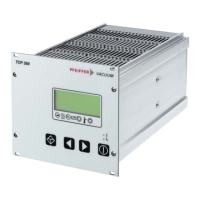Set parameter [P:777]
►
Set the parameter [P:777] according to the pump type.
Once the nominal rotation speed is reached, the turbopump will run at idle without additional gas
throughput. Depending on process or application requirements, the nominal rotation speed can be re-
duced in rotation speed setting mode or stand-by mode.
7.7.7 Stand-by
Pfeiffer Vacuum recommends stand-by mode for the turbopump during process and production stops.
When stand-by mode is active, the electronic drive unit reduces the rotation speed of the turbopump.
Stand-by mode is ineffective during rotation speed setting mode. The factory setting for stand-by mode
is 66.7% of the nominal rotation speed. Falling below or exceeding the specification in stand-by mode
activates or deactivates the status signal respectively [P:306] SetSpdAtt.
Setting the related parameters
1. Set the parameter [P:717] to the required value in %.
2. Set the parameter [P:026] to "0".
3. Set the parameter [P:002] to "1".
4. Check the set rotation speed (parameter [P:308] or [P:397]).
7.7.8 Backing pump operating modes
Operation of a connected backing pump via the electronic drive unit depends on the backing pump type.
Operating mode [P:025] Recommended backing pump
"0" Continuous operation All backing pumps
"1" Interval mode Diaphragm pumps only
Tbl. 27: Backing pump operating modes
Setting continuous operation
With "pumping station on", the electronic drive unit sends a signal to digital output pin 11 of the acces-
sory connection to switch on the backing pump.
1. Use an adapter cable to connect the relay box control cable to the "REMOTE" connection on the
electronic drive unit.
2. Set the parameter [P:025] to "0".
3. Use this signal for the control of a fore-vacuum safety valve.
Set interval operation and determine the switching threshold
Interval operation extends the service life of the diaphragm of a connected diaphragm pump. Either a
diaphragm pump with a built-in semiconductor relay or an interconnected relay box with a semiconduc-
tor relay is required for interval operation. The electronic drive unit switches the backing pump on or off
depending on the power consumption of the turbopump. A relationship to the fore-vacuum pressure re-
sults from the power consumption. The backing pump operating mode offers adjustable switch-on and
switch-off thresholds. Fluctuations in the power consumption of idling turbopumps and varying fore-vac-
uum pressures of the backing pumps require individual settings of the interval operation.
Pfeiffer Vacuum recommends interval operation between 5 and 10 hPa. A pressure gauge and a dosing
valve are required to set the switching thresholds.
1. Set the parameter [P:025] to "1".
2. Switch on the vacuum system with the parameter [P:010] ("pumping station").
3. Wait for the run-up.
4. Allow the gas to run via the dosing valve and set the fore-vacuum pressure to 10 hPa.
5. Read the drive power at parameter [P:316] and note the value.
6. Set the switch-on threshold of the backing pump with parameter [P:711] to the determined drive
power for a 10 hPa fore-vacuum pressure.
7. Reduce the fore-vacuum pressure to 5 hPa.
8. Read the drive power at parameter [P:316] and note the value.
9. Set the switch-off threshold of the backing pump with parameter [P:710] to the determined drive
power for a 5 hPa fore-vacuum pressure.
Operation
42/56

